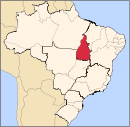Araguaína
Araguaína | |
|---|---|
 Location of Araguaína in the state of Tocantins | |
| Coordinates: 07°11′27″S 48°12′25″W / 7.19083°S 48.20694°W | |
| Country | Brazil |
| Region | Norte |
| State | Tocantins |
| Founded | 14 November 1958 |
| Government | |
| • Mayor | Ronaldo Dimas (PSDB) (2013 - 2016) |
| Area | |
• Total | 3,920.1 km2 (1,513.6 sq mi) |
| Elevation | 227 m (745 ft) |
| Population (2022[1]) | |
• Total | 171,301 |
| • Density | 38.33/km2 (99.3/sq mi) |
| Demonym | Araguainese |
| Time zone | UTC−3 (BRT) |
| Postal code | 77801 to 77901 |
| Area code | (+55) 63 |
| Website | http://www.araguaina.to.gov.br/ |
07°11′27″S 48°12′25″W / 7.19083°S 48.20694°W Araguaína (Brazilian Portuguese: [aɾaɡwaˈinɐ]) is a municipality located in the Brazilian state of Tocantins. Its population was 183,381 (2020), and its area is 4,000.40 square kilometres (1,544.56 sq mi).
Education
Higher education
The city has campuses from several higher education institutions.
There are two campuses of the public Federal University of Tocantins State (UFT). One campus is in the neighborhood Cimba, which has courses in Portuguese, English, Mathematics, physics, chemistry, geography, history, logistics, cooperativism, and tourism with the other campus situated outside the city, offering courses in veterinary sciences and zoology.
The city is home to the private university ITPAC, an educational institute offering medical, dentistry, and law classes.
Another private university is Santa Cruz, which has courses in law.
The private university Facit has courses in ortodontology, and software development.
Transport
Public transport in the city is done by the bus companies Cooperlota and Lontra.[citation needed]
The city is served by Araguaína Airport.
Climate
Araguaína experiences a tropical savanna climate (Köppen: Aw) with hot temperatures and distinct wet and dry seasons.
The city experiences a wet season from November to April. The dry season extends from June to September.[2]
Araguaína has hot and humid conditions throughout the year. September and October, before the wet season, are the hottest months, with average highs around 35 °C (95 °F).[2]
| Climate data for Araguaína (1991–2020) | |||||||||||||
|---|---|---|---|---|---|---|---|---|---|---|---|---|---|
| Month | Jan | Feb | Mar | Apr | May | Jun | Jul | Aug | Sep | Oct | Nov | Dec | Year |
| Mean daily maximum °C (°F) | 30.8 (87.4) |
31.0 (87.8) |
31.0 (87.8) |
31.5 (88.7) |
32.2 (90.0) |
33.0 (91.4) |
33.8 (92.8) |
35.1 (95.2) |
34.8 (94.6) |
32.9 (91.2) |
31.6 (88.9) |
31.1 (88.0) |
32.4 (90.3) |
| Daily mean °C (°F) | 25.2 (77.4) |
25.2 (77.4) |
25.3 (77.5) |
25.5 (77.9) |
25.5 (77.9) |
24.7 (76.5) |
24.4 (75.9) |
25.4 (77.7) |
26.4 (79.5) |
26.1 (79.0) |
25.7 (78.3) |
25.4 (77.7) |
25.4 (77.7) |
| Mean daily minimum °C (°F) | 21.6 (70.9) |
21.7 (71.1) |
22.0 (71.6) |
21.8 (71.2) |
21.0 (69.8) |
18.5 (65.3) |
17.1 (62.8) |
17.5 (63.5) |
19.7 (67.5) |
21.0 (69.8) |
21.6 (70.9) |
21.7 (71.1) |
20.4 (68.7) |
| Average precipitation mm (inches) | 259.1 (10.20) |
272.7 (10.74) |
293.6 (11.56) |
211.2 (8.31) |
94.6 (3.72) |
21.6 (0.85) |
8.4 (0.33) |
11.1 (0.44) |
51.6 (2.03) |
120.3 (4.74) |
206.0 (8.11) |
211.7 (8.33) |
1,761.9 (69.37) |
| Average precipitation days (≥ 1.0 mm) | 17.2 | 18.2 | 18.8 | 15.2 | 8.1 | 1.9 | 0.8 | 1.3 | 4.0 | 9.0 | 12.5 | 14.5 | 121.5 |
| Average relative humidity (%) | 85.6 | 85.9 | 86.8 | 85.5 | 80.8 | 71.9 | 63.8 | 57.8 | 63.8 | 76.1 | 82.7 | 84.6 | 77.1 |
| Average dew point °C (°F) | 23.0 (73.4) |
23.0 (73.4) |
23.3 (73.9) |
23.4 (74.1) |
22.7 (72.9) |
20.4 (68.7) |
18.4 (65.1) |
17.9 (64.2) |
19.9 (67.8) |
22.2 (72.0) |
23.0 (73.4) |
23.1 (73.6) |
21.7 (71.1) |
| Mean monthly sunshine hours | 124.6 | 111.8 | 114.6 | 143.9 | 202.7 | 250.8 | 281.0 | 284.3 | 214.1 | 154.1 | 123.3 | 119.3 | 2,124.5 |
| Source: NOAA[2] | |||||||||||||
References
- ^ "IBGE 2022". Retrieved 3 July 2024.
- ^ a b c "World Meteorological Organization Climate Normals for 1991-2020 — Araguaína". National Oceanic and Atmospheric Administration. Retrieved January 29, 2024.




